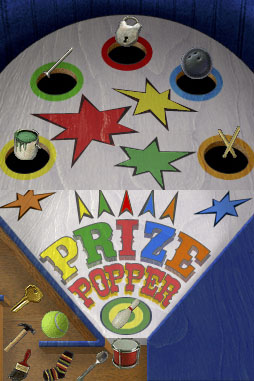
While there's no doubt that circuses are supposed to be happy places, the reason for this misapprehension is no longer clear. Nowadays, an unmistakable fug of disgrace enshrouds the circus like a pall of smoke, partly through its association with the freak-tainted tradition of vaudeville, and partly because most of the acts that take place in the big top seem likely to culminate in violent public death.
All the best children's media are vaguely terrifying, steeped in a kind of surreal menace, and I Spy Fun House, based on Jean Marzello and Walter Wick's series of 'picture riddles', is no exception. Like the best children's fiction, it's also beautiful, bizarre, and almost as compelling for adults as it is for its intended audience.
While it's undoubtedly aimed at children, I Spy Fun House's look is far from simplistic or cartoonish. The graphics are detailed and the style is straight from Carnivále: richly-detailed, dim-lit, washed-out, filled with old-fashioned vaudeville typeface and smoky art nouveau curls.
The object of the game is to earn enough tickets to escape the Fun House, a cluttered tent filled with circus paraphernalia: a carousel horse, a mouse peering into a distorted mirror, a dog preparing to jump through a hoop, a hovering gumball machine, a pair of spiralling x-ray specs, a spinning top, a music box, some balloons, and an elephant nightmarishly emerging from a poster, bouncing a yo-yo with its trunk.
This is the menu screen, and there are no words. To enter a sub-game, you just tap your stylus on one of the animated objects.
Being I spy, the majority of the sub-games involve looking for things, but there are three other games to provide some variety.
Tapping on the music box presents you with a 'Simon says' exercise in which you have to follow the order of an increasingly lengthy sequence of button presses and their associated sounds. The gumball machine, meanwhile, takes you into a very easy match-'em-up puzzler in which you have to bring shapes, colours, or types together.
The best of the three follows tapping on the dog. In this sub-game, an array of hoops drifts across the top screen containing various objects, and another set of objects slides along the bottom of the lower screen. Between them is an elasticated rope, and the object is to work out which of the lower objects belongs in which hoops above and then to launch them, bow and arrow-like, into the appropriate groupings.
If a hoop contains a coin, say, this could mean either that all round things should be launched up there, or all metal things. You have to work it out. If two hoops overlap, the elliptical space they share takes on the characteristics of both hoops, so that if one contains dogs and the other metal things, the overlap has to contain metal dogs.
It's not rocket science for powernerds like us, but using the stylus to ping the objects up is satisfying, and the rapid taxonomy the game requires is almost certainly useful in helping kids organise their thoughts and identify patterns. In fact, it plays like Dr Kawashima's Brain Training, but looks much more interesting.
The rest of the sub-games all contain one task: looking for stuff. Tapping on the elephant poster, for instance, brings you a close-up of the poster and a set of 'I spy…' instructions; some straightforward, such as 'a hammer', and some borderline cryptic, such as 'a small price.'
Using the stylus to slide the poster around, you have to search out the specified objects, tapping on them to elicit a little discovery animation.
You might think looking for hidden objects is too remedial an activity to make a compelling video game, and up until we played this we'd have thought so too. However, I Spy Fun House confounds expectations just as it defies genre. It works because the illustrations are stunning, off-beat menageries of beautifully drawn bric-a-brac, and hunting for their teeming, artfully integrated secrets is a joy.
I Spy Fun House is half game, half picture book, and arguably closer to the latter. For that reason, it's not in the same league as much of the DS's catalogue, but it has the honour of being in a strange little league of its own. If you have young children, we recommend it unreservedly.
I Spy Fun House

